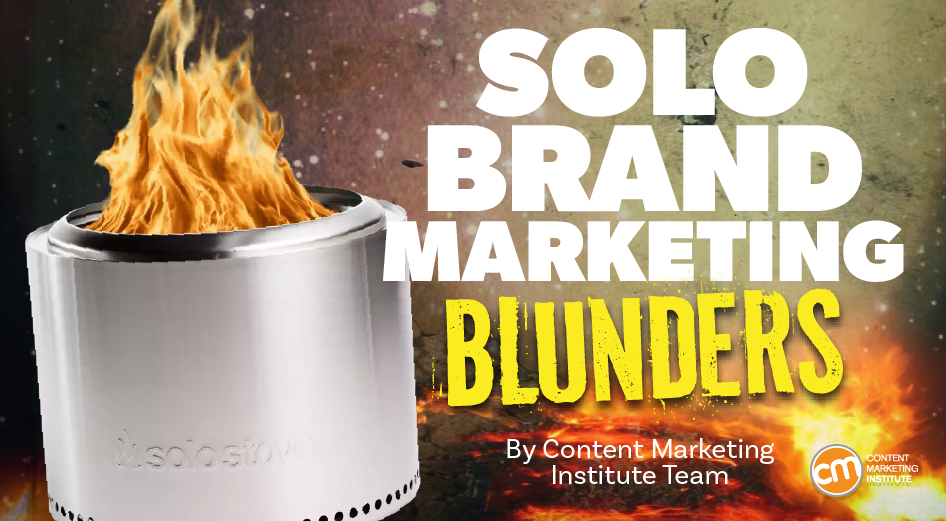Last week, Solo Brands, the parent company of direct-to-consumer-brands Solo Stove and others, appointed Christopher T. Metz as its president, chief executive officer, and director of the board.
But that isn’t the interesting story.
The story is why Solo Brands switched their brand quarterback. The CFO said Solo’s unique marketing campaigns didn’t deliver the expected revenue, negatively impacting company results.
Look out. Here comes another bus to throw marketing under.
We turned to Robert Rose, CMI’s chief strategy advisor, for his take. Watch the video or read on for his insight:
Snoop Dogg campaign leads to CEO exit
Rapper Snoop Dogg made the news again last week for a campaign he did last November for Solo Stove.
You may remember Snoop’s headline-making tweet: “After much consideration and conversation with my family, I’ve decided to give up smoke. Please respect my privacy at this time.”
It went viral across social media channels and through mainstream news coverage. It went viral because the only celebrity more associated with smoking weed than Snoop Dogg might be Willie Nelson. But was Snoop really quitting? Was he going to edibles only now?
No. The tweet was part of a brand awareness campaign for Solo Stove’s new smokeless stove. In a follow-up video, Snoop explains he’s tired of coughing and his clothes smelling bad. As the camera pans wider, it reveals Snoop sitting in front of a smokeless Solo Stove firepit.
What an incredible influencer and brand awareness campaign, right? It amassed 30 million likes, comments, and shares on social media. Ad Age even ranked it 18th (registration required) in their 40 best ads of 2023.
What could possibly go wrong?
Well, Solo says it didn’t work and threw the marketing campaign under the bus for their slightly lower guidance on revenue — and seemingly replaced the CEO because of it.
In its new CEO announcement release, the interim CFO said, “While our unique marketing campaigns raised brand awareness of Solo Stove to an expanded and new audience of consumers, it did not lead to the sales lift that we had planned, which, combined with the increased marketing investments, negatively impacted our EBITDA.”
She continued, “We believe that there is a significant opportunity for us to build awareness and that these new campaigns will expand our reach and benefit our brands over the long term.”
Blunder: Brand awareness with sales as a success metric
Solo said with a straight face that the brand awareness campaign started in November 2023 didn’t provide a revenue lift within six weeks. SIX. Weeks. They probably hadn’t even paid the agency’s bill yet. Let that sit there for the moment.
You should pay attention to and acknowledge two things from this situation.
First, it is a great example of something I frequently teach — apply the right business goals and objectives to the right part of the marketing journey. When the business and marketing goals don’t align, don’t be surprised when nobody meets any of them.
Solo conducted a brand awareness campaign. As a marketer, I can tell it was designed for pure brand awareness because of the social posts, TikTok videos, and, of course, the ad posted to its YouTube channel, which sits at 1.1M videos as we publish this. None of the content included a call to action other than a simple “learn more” at the end of the video ad that took viewers to Solo Stove’s website.
Brilliant content and wonderfully delivered. Solo created a perfect vehicle for generating more conversation and awareness about its brand. It did not build the content for conversions.
They said as much a month after the launch. In The Daily, a magazine for outdoor retailers, then CEO John Merris discussed bringing in Martin Agency to help create the campaign and clarified its purpose, “You certainly aren’t tracking it to revenue … You’re tracking it to things like unaided brand awareness.”
I’m an outsider looking in, and the Solo team may have better insight. But if brand awareness was the business objective and all the marketing leaders agreed, failing the campaign because it didn’t reach revenue objectives is just plain wrong. The campaign wasn’t designed to lift revenue, not to mention it was given only six weeks to do it.
Blunder: Audience-building content without CTAs to retain audience
Now, I have challenges with their strategy of “building audiences” through the campaign. In my world, The Solo campaign would have had CTAs to build an audience. Why not invite the audience to become part of Snoop’s Smokeless World? They could generate their custom “smokeless plan,” download all the benefits of going smokeless, and have all kinds of interactive fun. Solo would have built an addressable audience.
That was the actual marketing fail — they didn’t connect the campaign to anything else. They had a brilliant concept for an amazing, differentiating story told by an exceptional influencer and connected it to zero part of their customer’s journey. All the links from their beautifully designed campaign? All go to Solo’s boring e-commerce storefront — greatly functional if you want to buy a stove but awful if you want to understand why you might buy a smokeless stove.
They could have continued the Snoop story into the demand-gen part of the journey, developing more interest in and shopping for the stoves. They could have used the goodwill and brand recall to get more people interested in smokeless stoves and fire pits.
In CMI and TCA’s first-party data workshop, we teach how to use engagement and interaction with content to learn how to serve the best next experience. Once marketers get someone’s attention, what’s the best next experience that person could have? Connect that to the content that got them in the theater and hold them there.
That’s integrating your content and marketing strategy.
As you think about ways to launch that amazing, new, disruptive, viral content your creative team has discovered, just remember this story. Ask how you can connect that content to a larger, best next experience so your audience always has someplace to go deeper, learn more, and develop a relationship with you and your brand.
HANDPICKED RELATED CONTENT:
Cover image by Joseph Kalinowski/Content Marketing Institute











